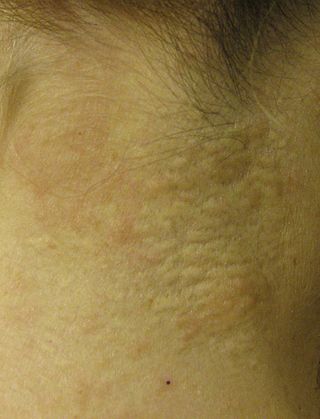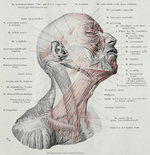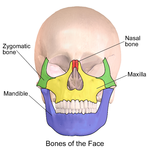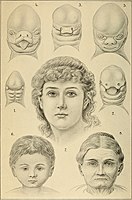
A smile is a facial expression formed primarily by flexing the muscles at the sides of the mouth. Some smiles include a contraction of the muscles at the corner of the eyes, an action known as a Duchenne smile. Among humans, a smile expresses delight, sociability, happiness, joy, or amusement. It is distinct from a similar but usually involuntary expression of anxiety known as a grimace. Although cross-cultural studies have shown that smiling is a means of communication throughout the world, there are large differences among different cultures, religions, and societies, with some using smiles to convey confusion, embarrassment or awkwardness.
Affective computing is the study and development of systems and devices that can recognize, interpret, process, and simulate human affects. It is an interdisciplinary field spanning computer science, psychology, and cognitive science. While some core ideas in the field may be traced as far back as to early philosophical inquiries into emotion, the more modern branch of computer science originated with Rosalind Picard's 1995 paper on affective computing and her book Affective Computing published by MIT Press. One of the motivations for the research is the ability to give machines emotional intelligence, including to simulate empathy. The machine should interpret the emotional state of humans and adapt its behavior to them, giving an appropriate response to those emotions.
A facial expression is one or more motions or positions of the muscles beneath the skin of the face. According to one set of controversial theories, these movements convey the emotional state of an individual to observers. Facial expressions are a form of nonverbal communication. They are a primary means of conveying social information between humans, but they also occur in most other mammals and some other animal species.

Facial perception is an individual's understanding and interpretation of the face. Here, perception implies the presence of consciousness and hence excludes automated facial recognition systems. Although facial recognition is found in other species, this article focuses on facial perception in humans.

Prosopagnosia, also known as face blindness, is a cognitive disorder of face perception in which the ability to recognize familiar faces, including one's own face (self-recognition), is impaired, while other aspects of visual processing and intellectual functioning remain intact. The term originally referred to a condition following acute brain damage, but a congenital or developmental form of the disorder also exists, with a prevalence of 2.5%. The brain area usually associated with prosopagnosia is the fusiform gyrus, which activates specifically in response to faces. The functionality of the fusiform gyrus allows most people to recognize faces in more detail than they do similarly complex inanimate objects. For those with prosopagnosia, the method for recognizing faces depends on the less sensitive object-recognition system. The right hemisphere fusiform gyrus is more often involved in familiar face recognition than the left. It remains unclear whether the fusiform gyrus is specific for the recognition of human faces or if it is also involved in highly trained visual stimuli. Prosopoagnosic patients are under normal conditions able to recognize facial expressions and emotions.

The fusiform gyrus, also known as the lateral occipitotemporal gyrus,is part of the temporal lobe and occipital lobe in Brodmann area 37. The fusiform gyrus is located between the lingual gyrus and parahippocampal gyrus above, and the inferior temporal gyrus below. Though the functionality of the fusiform gyrus is not fully understood, it has been linked with various neural pathways related to recognition. Additionally, it has been linked to various neurological phenomena such as synesthesia, dyslexia, and prosopagnosia.

Physical attractiveness is the degree to which a person's physical features are considered aesthetically pleasing or beautiful. The term often implies sexual attractiveness or desirability, but can also be distinct from either. There are many factors which influence one person's attraction to another, with physical aspects being one of them. Physical attraction itself includes universal perceptions common to all human cultures such as facial symmetry, sociocultural dependent attributes, and personal preferences unique to a particular individual.
Phakomatoses, also known as neurocutaneous syndromes, are a group of multisystemic diseases that most prominently affect structures primarily derived from the ectoderm such as the central nervous system, skin and eyes. The majority of phakomatoses are single-gene disorders that may be inherited in an autosomal dominant, autosomal recessive or X-linked pattern. Presentations may vary dramatically between patients with the same particular syndrome due to mosaicism, variable expressivity, and penetrance.

Pseudoxanthoma elasticum (PXE) is a genetic disease that causes mineralization of elastic fibers in some tissues. The most common problems arise in the skin and eyes, and later in blood vessels in the form of premature atherosclerosis. PXE is caused by autosomal recessive mutations in the ABCC6 gene on the short arm of chromosome 16 (16p13.1).

The fusiform face area is a part of the human visual system that is specialized for facial recognition. It is located in the inferior temporal cortex (IT), in the fusiform gyrus.

A dysmorphic feature is an abnormal difference in body structure. It can be an isolated finding in an otherwise normal individual, or it can be related to a congenital disorder, genetic syndrome or birth defect. Dysmorphology is the study of dysmorphic features, their origins and proper nomenclature. One of the key challenges in identifying and describing dysmorphic features is the use and understanding of specific terms between different individuals. Clinical geneticists and pediatricians are usually those most closely involved with the identification and description of dysmorphic features, as most are apparent during childhood.
Smoker's face describes the characteristic changes that happen to the faces of many people who smoke tobacco products. Smoking causes damage to the skin by depleting the skin of oxygen and nutrients. The general appearance is of accelerated ageing of the face, with a characteristic pattern of facial wrinkling and sallow coloration.

Keratolytic Winter erythema is a rare autosomal dominant skin disease of unknown cause which causes redness and peeling of the skin on the palms and soles. Onset, increased prominence and severity usually occurs during winter. It is a type of genodermatosis.
Visual object recognition refers to the ability to identify the objects in view based on visual input. One important signature of visual object recognition is "object invariance", or the ability to identify objects across changes in the detailed context in which objects are viewed, including changes in illumination, object pose, and background context.
Memory supports and enables social interactions in a variety of ways. In order to engage in successful social interaction, people must be able to remember how they should interact with one another, whom they have interacted with previously, and what occurred during those interactions. There are a lot of brain processes and functions that go into the application and use of memory in social interactions, as well as psychological reasoning for its importance.
Emotion perception refers to the capacities and abilities of recognizing and identifying emotions in others, in addition to biological and physiological processes involved. Emotions are typically viewed as having three components: subjective experience, physical changes, and cognitive appraisal; emotion perception is the ability to make accurate decisions about another's subjective experience by interpreting their physical changes through sensory systems responsible for converting these observed changes into mental representations. The ability to perceive emotion is believed to be both innate and subject to environmental influence and is also a critical component in social interactions. How emotion is experienced and interpreted depends on how it is perceived. Likewise, how emotion is perceived is dependent on past experiences and interpretations. Emotion can be accurately perceived in humans. Emotions can be perceived visually, audibly, through smell and also through bodily sensations and this process is believed to be different from the perception of non-emotional material.
Progeroid syndromes (PS) are a group of rare genetic disorders that mimic physiological aging, making affected individuals appear to be older than they are. The term progeroid syndrome does not necessarily imply progeria, which is a specific type of progeroid syndrome.
Injectable filler is a soft tissue filler made of polysaccharides injected into the skin at different depths.
The face inversion effect is a phenomenon where identifying inverted (upside-down) faces compared to upright faces is much more difficult than doing the same for non-facial objects.
The occipital face area (OFA) is a region of the human cerebral cortex which is specialised for face perception. The OFA is located on the lateral surface of the occipital lobe adjacent to the inferior occipital gyrus. The OFA comprises a network of brain regions including the fusiform face area (FFA) and posterior superior temporal sulcus (STS) which support facial processing.


















